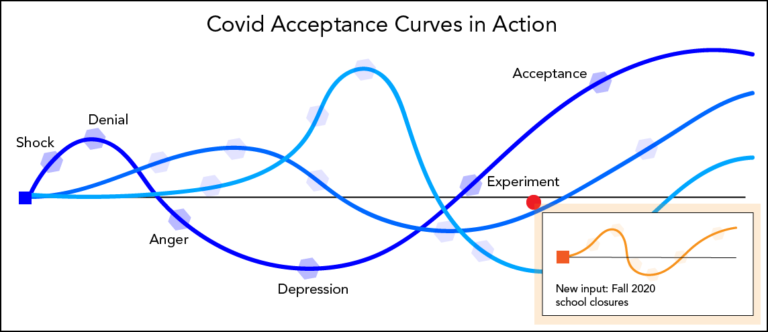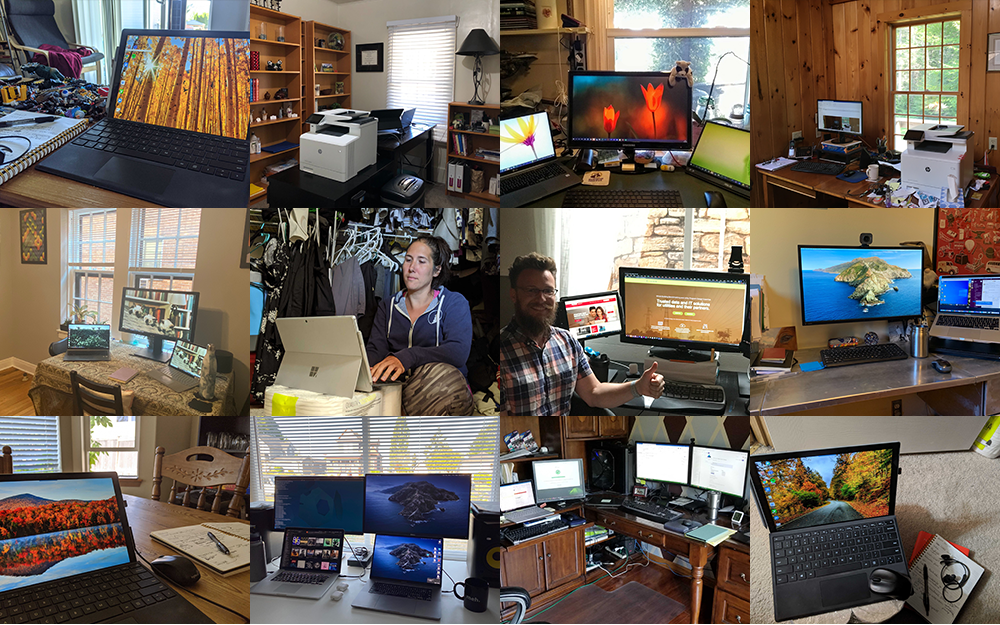My Covid Acceptance Curve: Supporting Staff in 2020 Means Custom Solutions
In product management, there’s a golden rule: run head-first towards the problem. After you get there, analyze, solution, revise, roll-out and repeat.
As the CEO of a small technology company with a background in product management, I use this framework all the time. Many leaders do. It’s our job to find answers to complicated problems, often using a systems mindset: market problems, customer problems, operational problems, communication problems. And it’s a particular “sweet spot” for any of those when you find a solution that solves multiple problems at once, across personas.
So, one of my 2020 management problems: how do we support our people as we navigate the coronavirus pandemic?
Great question. I don’t want to mince words: There is no “sweet spot” solution. Covid makes my go-to, problem-first approach damn-near impossible. Everyone’s problems, and needs, differ. In fact, many of their needs are in opposition, and I know full well that I don’t know half of the challenges my team is facing. For someone who systematically organizes the world around me into a framework of problems and solutions, I’ve been knee-capped. I desperately want to define this problem. But I can’t. We can’t.
I’m starting to understand why, and I’m calling it the “Covid Acceptance Curve(s).” Allow me to put on my former high school English teacher glasses and explain. Kubler-Ross’s change curve is nothing new, and Covid dropped us all on a roller coaster ride barreling into a tunnel of shock, denial, anger and depression.
We’re all on our own curves, and we can’t know where this ride is going to take us. Deciding how to move forward and integrate these unprecedented changes into our lives – the “acceptance” part of the curve – is an ongoing, iterative, disparate process for each of us.
As a company, we can’t do anything to change these realities, and many possible solutions for one employee are actually counter-indicated for others. Think of your team as an overlapping series of waves, each strand representing a person and their curve. You could try to slot in a single solution across “strands,” but it will inevitably miss so many marks, reaching people too late, too early or with something that isn’t even relevant to them. And to further complicate the search for a solution, many of us are reliving stages in different contexts and as new data arises, putting us on whole new curves. It’s a tangled web of emotional journeys.

Back to my big problem: what does this mean when it comes to a company trying to support people? In the product world, this might be where we’d have a discussion about the 80/20 rule, or Pareto Principle. I’ll spare you and say this instead: there’s no way to narrow the effort or focus here.
One of my own curves has been accepting that these aren’t solvable problems. Right now, my job is listening and not letting my brain look for a “sweet spot.” There are too many dots on too many “Covid Acceptance Curves.” Some are experimenting with how to juggle work and homeschooling, some are struggling with crippling isolation, some have been impacted by Covid personally, others are facing anxiety of so many kinds. And we represent varied beliefs and fears about what comes next.
So, separate each “strand,” open and reopen individual dialogues and empower managers to do the same. Some of our people need hardware or furniture. Some need an ear. Some need a break. Some need more meetings; some less. Some want to talk about Covid; some don’t. They all need many things we can’t provide.
For my product manager’s brain, this is undoing years of training. In 2020, I’m learning to look for custom solutions instead of agnostic problems. But I’m convinced it’s the only way I might be able to find some unique, specific problems we can actually help solve. This is a moment in time when it’s not about the system at all, but its component parts. Our people.
The pandemic has shifted some fundamental expectations for leaders. Our employees need managers who can navigate a wholly new reality of diverse milestones and divergent deliverables. We have to step out of our answer-seeking mindsets. Instead, we need to follow behind our people, picking up strings and tying knots where we can. We’re looking for individual wins. This is hard. And it doesn’t feel scalable at all, because it isn’t. But right now, it’s the single most effective thing we can do for our people.

We’re all working to figure out what makes sense, what works for each of us individually, in 2020.
This blog post led to an interview with Calico CEO, Colleen Morris featured on ZDNet.

About the author...
Colleen Morris is Calico Energy’s President and CEO. With deep experience in product management and strategic visioning, she’s able to effectively lead Calico’s consultants and technologists as they build useful, relevant solutions for utility and market customers. To find about more about Colleen, read her bio.
Check out the latest from our blog…
Interested in learning more about Calico's team?
Looking for additional resources?
Head to our Resources page for more industry perspectives and product information.
